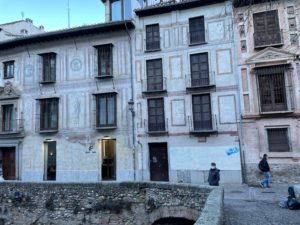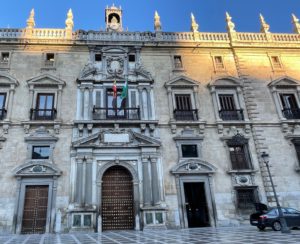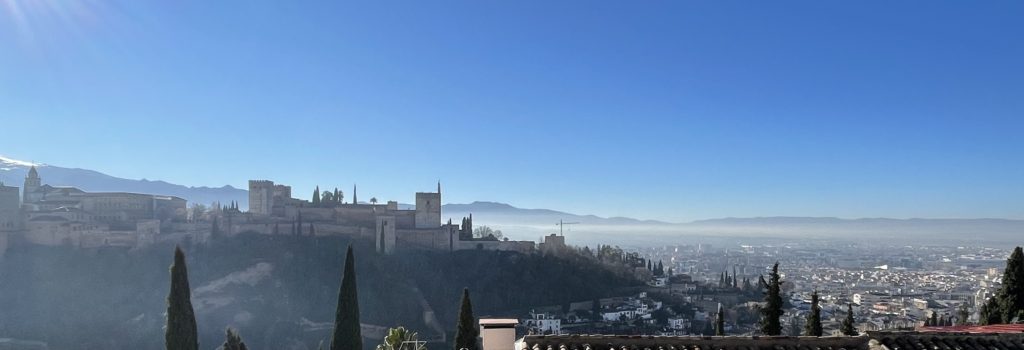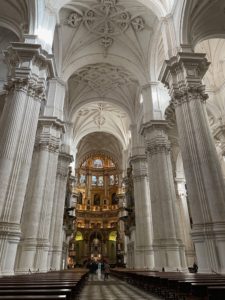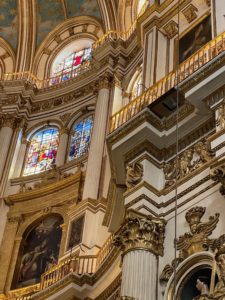In which Sid and Doris tour Granada but not the Big One.
The National Theatre of Brent version of the history of the region goes like this: Homo Sapiens arrives 25,000 BC, Iron Age settlements, Iberians trading with Phoenicians (Lebanese) and Carthaginians, Greeks (though see 1821 and all that for creation of modern Greece), Romans ruling from 206 BC but going home when the middle Europeans come in 5th century, to be supplanted by the Moors (back from Carthage?), Moors gradually (Re)conquista-ed, rule by Catholic monarchs from 1,492, treasure from New World builds new magnificence but Spain declines under Hapsburgs, 19th century backward agricultural society lorded over by land owners and Catholic Church, socialist and anarchist uprisings leading to 1936-39 civil war as Fascists overthrow Republic (despite George Orwell’s best efforts), Franco’s rule to his death in 1975 (during which time Catalonia kept poor as retribution for Red past), democratic country joins European Union in 1986.
As we walk around Granada questions occur to Sid and Doris. So where did each of the populations go when the new conquerors came? Where did the Moors and Jews go? Did Algeciras port look like Kabul airport?
This Civil War. It is dated from the Nationalists’ military uprising in 1936. What were the pre-cursers? There were anti clerical riots in the early 20th century. In 1931 convents, monasteries and churches were burnt as Anarchists and Socialists attacked the Church and landlords. After the first two months of the Civil War Antony Beevor estimates maybe 3,400 clerics had been murdered. There were White Terrors and Red Terrors, and of course the Reds murdered one another for their own special heresies. In all the death toll seems to have been 500,000 or so just 85 years ago. There is any amount of information about Mudejar architecture in Granada but a bit light on this stuff.
Sid and Doris make a grand tour of the town spying the Royal Chancery, views of the Alhambra, the gardens of the Casa del Chapiz (with persimmons and black squirrels).
Up to a mirador (with fabulous views but unconvincing troubadours covering the Gypsy Kings) where we find the chapel of San Nicholas.
While Doris gets the iPhone to work its magic on the view, Sid finds an information board with the first public recognition we’ve seen of the Civil War. While the chapel had been hit by lightening in 1828 and needed rebuilding it was near enough destroyed in the anti-clerical riots of 1931, during the Second Republic. Polarisation is a popular word in politics just now. Anarchists and socialists vs authoritarian Catholics? It was always going to be a lively debate. Help from the NKVD, Germany and Italy plus about 40,000 Laurie Lees and International Brigaders was going to make for a busy afternoon. And the Franco regime made Ireland’s Magdalene Laundries seem rather benign.
And so to the cathedral, ordered by Queen Isabella in 1530 is recent, for Spain. Though based on the model of Toledo cathedral much of the building is of the same era as St Pauls in London and it feels similar. Granada’s facade dates from 1667, the fire of London was 1666. The modern-day holiday involves coach journeys and tour guides but the groups assembled outside the cathedral still seem to have some essence of pilgrimage about them. (“Tourism is the new religion. Discuss.”)
 A highlight for Sid, aside from the general splendour, is this ‘war memorial’ for the Catholic martyrs of Marxism. And the best bit at the bottom of the picture is the Roman date, 1939 ‘the year of the victory’ (end of the civil war and triumph of Catholic supported Franco). It would not be to condone or celebrate those murders to note that just 58% of (mostly older) Spaniards now identify as Catholics and 38% (mostly younger) as atheists, womens’ mean age at first birth is 31 years, the Spanish Socialist Workers’ Party has been in government longer than any other party since democracy’s return. Victories, how long do they last? 1939 to 1975, not forty years.
A highlight for Sid, aside from the general splendour, is this ‘war memorial’ for the Catholic martyrs of Marxism. And the best bit at the bottom of the picture is the Roman date, 1939 ‘the year of the victory’ (end of the civil war and triumph of Catholic supported Franco). It would not be to condone or celebrate those murders to note that just 58% of (mostly older) Spaniards now identify as Catholics and 38% (mostly younger) as atheists, womens’ mean age at first birth is 31 years, the Spanish Socialist Workers’ Party has been in government longer than any other party since democracy’s return. Victories, how long do they last? 1939 to 1975, not forty years.
We had resigned ourselves to not visiting the Alhambra – you need to book ages in advance and we have found that when touring with a classic car that can induce Destination Anxiety. But when we got back to the hotel the concierge told us that Yes! You Will Go To The Palace! So that is tomorrow’s treat, followed by a late departure to Murcia. We think the Alhambra must have felt pretty solid in the tenth century.
 PS For dinner we turned determinedly away from the “tourist recommended” network of tapas places in cute little pedestrian-only roads and found instead the Restaurant Las Tinajas where we had a great time people-watching and eating yummy food. When ordering one dish we couldn’t decide between the fried red mullet and the prawns. “Why not order half and half?” said the waiter. What a star!! We hope there is a special corner of restaurant heaven reserved for people like him.
PS For dinner we turned determinedly away from the “tourist recommended” network of tapas places in cute little pedestrian-only roads and found instead the Restaurant Las Tinajas where we had a great time people-watching and eating yummy food. When ordering one dish we couldn’t decide between the fried red mullet and the prawns. “Why not order half and half?” said the waiter. What a star!! We hope there is a special corner of restaurant heaven reserved for people like him.
